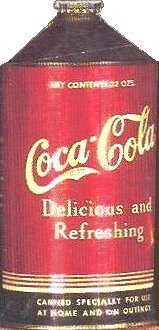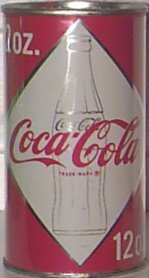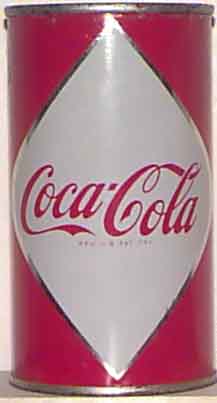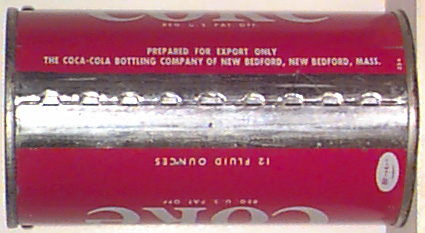This page brought to you by:
http://www.CollectibleSodaCans.com
COKE CAN HISTORY
Although the idea for canning Coca Cola began in the 1930's, culminating
with the creation of a 16oz and a 32 oz cone top can in 1936, no real progress
was made until the 1950's. Neither of these cone tops appear to have actually
gone into production, but were used as samples.

The only known Coke 32 ounce cone top!
JUMP to the Diamond with a bottle design
information
JUMP to the Harlequin design
information
The first actual production can for Coke was a test market can
which was produced out of the Hayward, CA plant for export to American Troups
overseas in late 1955. A second can from the New Bedford Mass plant for export
to the American troops in the far east was produced in early 1956. The Hayward
can is quite a bit more difficult to locate however. There is one tell tale
identifier on this can which seperates it from the rest. On the side of the
can above the seam, the sentence "Prepared for export only" exists. This
is an extremely tough can to find and even tougher to find in very good shape.
The other somewhat unique feature is in the lids that were used. The original
experimental lids did not have any production information, but rather had
very plain & somewhat familiar Coke logo's.
NEW BEDFORD, MA. TEST CAN FROM 1955
Click image for a higher resolution
picture
The primary reason for the test market being the military in the far east,
was due to the question the Coke executives had about the taste of Coke in
cans. It must have worked out well enough because later that year and in early
1956 a second test market can was
attempted. The only difference that can had from the first was the removal
of the "Prepared for export only" indicator above the seam. The common ground
indicator that both of the two test market cans had that none of the later
cans showed was the "REG. U.S. PAT. OFF."
line below the Coca-Cola in the large diamond. The first regular production
Diamond can and all of the later Diamond with the bottle cans would have "TRADE MARK
R" in its place. Both of the early test market cans extremely tough cans
in good condition.
That test did not last for two long a time before the executives
decided thay weren't quite ready for the change to cans.
The success that other canners were having did force Coke to wake
up and smell the syrup, so to speak, and they did introduce the first
regular production can in 1960 to enter the national market. That
final large diamond can is also a very desirable can today and can be
pretty challenging to locate in high grade.
1961 brought about the first real generation change in cans
for Coke. They introduced the first bottle
design within the diamond for the first time. The can pictured was loaned
from the collection of Fred Dobbs. It is similar to the second
design, which appeared in 1963, but without the large 12 OZ labels above
left and below right of the diamond. The other important detail of the bottle
design is that all three can be found in the earlier punch top which required
a church key to open as well as with an early
design of the pull tab.

Second generation diamond bottle can - probably the most commonly
seen!
Click image for a higher resolution
picture
The third and final change, which
made its first appearance in 1965, for the bottle design was again to remove
the large 12 OZ indicators above and below the diamond and to replace them
with a single, smaller line stating "Contents 12 FL OZS" which can be
found at the base of the diamond.
Although the bottle design cans are much more common than the
ealier plain diamond cans, they are nonetheless, still very
desirable.
1966 saw another generation change as Coke
moved to the Harlequin design that is sometimes indicated as the
small diamond can. The first
version is available as a flat and a pull top, with the flat top
being a much tougher find. The distinction between the first and
second version of this can is made by the placement of the "Contents
12 FL OZS". The first version has it at the top, while the second,
available only as a pull tab for the first time, shows it at the
bottom.
The final version of this can made it's appearance in 1967. It was Coke's
first effort at using an all aluminum design. This can is easily distinguished
from its predecessor due to the indented ridge at the top lid and the curved
aluminum shape at the base with no true bottom lid. In addition, the All Aluminum
statement is made on the bottom of the can. A second
and more common all aluminum can quickly made it's debute, but this time the
all aluminum statement was on the side of the can.
The harlequin designs remained in use until the next generation
change which took place in 1970 as coke moved to it's spiral design
which we are still familiar with today. Take a look at the first
spiral design can, a very difficult to find two panel dull red
flap top - notice that the one content line lists "Carmel Colored" as
the only item. This can was also available in metallic
paint. The second
spiral design, released in 1971 had a shorter "Coke" on the side
panel, yet still only listed one content line. It is also available
in dull red or metallic paint.
An interesting aside for the Coke collector that must have every can, in
1966, Coke test marketed a 16 oz version of the harlequin design from its
Portland, OR plant. This is an extremely tough find and is considered a very
rare can!
The first larger scale production
16 oz can came out in 1971 and was a dull version of the first spiral
design from above with one content line. It is pretty tough to find!
Another tough find is the only domestic 10 ounce can, from Gretna, LA in
1976. It's a very rare can that could easily be mistaken for a Canadian can.

Although, the cans pictured are not for sale, I periodically do have some
traders that I will use to add missing cans to my collection. I am most interested
in early flat top and cone top soda cans in high grade.
All rights reserved. No images or information may be reproduced without the
written consent of the author. Please contact me with questions.
http://www.CollectibleSodaCans.com




